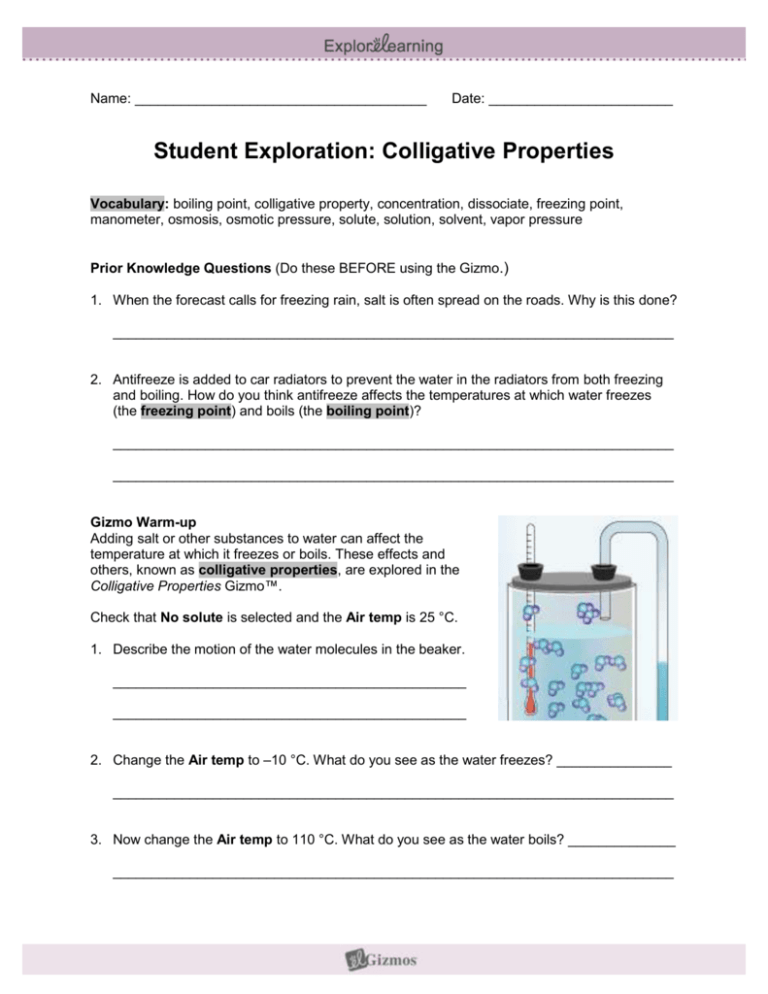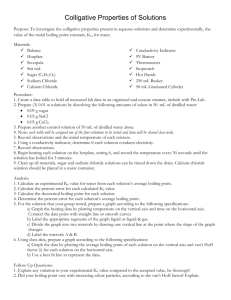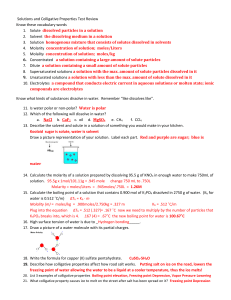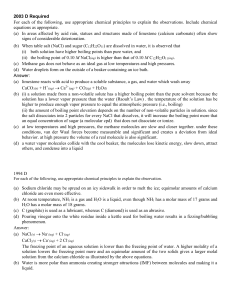Colligative Properties Gizmo
advertisement

Name: ______________________________________ Date: ________________________ Student Exploration: Colligative Properties Vocabulary: boiling point, colligative property, concentration, dissociate, freezing point, manometer, osmosis, osmotic pressure, solute, solution, solvent, vapor pressure Prior Knowledge Questions (Do these BEFORE using the Gizmo.) 1. When the forecast calls for freezing rain, salt is often spread on the roads. Why is this done? _________________________________________________________________________ 2. Antifreeze is added to car radiators to prevent the water in the radiators from both freezing and boiling. How do you think antifreeze affects the temperatures at which water freezes (the freezing point) and boils (the boiling point)? _________________________________________________________________________ _________________________________________________________________________ Gizmo Warm-up Adding salt or other substances to water can affect the temperature at which it freezes or boils. These effects and others, known as colligative properties, are explored in the Colligative Properties Gizmo™. Check that No solute is selected and the Air temp is 25 °C. 1. Describe the motion of the water molecules in the beaker. ______________________________________________ ______________________________________________ 2. Change the Air temp to –10 °C. What do you see as the water freezes? _______________ _________________________________________________________________________ 3. Now change the Air temp to 110 °C. What do you see as the water boils? ______________ _________________________________________________________________________ Activity A: Vapor pressure and boiling point Get the Gizmo ready: Check that No solute is selected. Set the Air temp to 25 °C. Introduction: At the surface of a body of water, water molecules are constantly moving from the liquid phase to the gas phase, and vice versa. The molecules that evaporate collide against the walls of the beaker, creating vapor pressure. Vapor pressure can be measured by a manometer, a liquid-filled tube that is connected to the top of the beaker. Increasing the vapor pressure pushes the water in the tube, causing the water in the right arm of the tube to rise to a higher level than the water in the left arm of the tube. Question: How does salt affect the properties of water? 1. Observe: Gradually increase the Air temp to 95 °C. As you do this, observe the water in the manometer. What do you notice, and what does this indicate about the vapor pressure? ________________________________________________________________________ ________________________________________________________________________ 2. Record: Click the Record button below the table to see the vapor pressure in kilopascals (kPa). Use the Gizmo to find the vapor pressure at 5 °C, 50 °C, and 95 °C. 5°C: ________ 50 °C: ________ 95 °C: ________ 3. Analyze: How does the temperature of the liquid relate to the vapor pressure? ___________ _________________________________________________________________________ 4. Measure: To measure the boiling point, increase the Air temp to 110 °C. When you see bubbles, click Record. The water temperature at this time is equal to the boiling point. A. What is the boiling point of pure water? ______________________ B. What is the current vapor pressure? ______________________ C. Atmospheric pressure at sea level is equal to 101.32 kilopascals (kPa). Why do you think water boils when the vapor pressure is equal to atmospheric pressure? ___________________________________________________________________ ___________________________________________________________________ ___________________________________________________________________ (Activity A continued on next page) Activity A (continued from previous page) 5. Compare: Click Clear. Set the Air temp. to 25 °C, and click Record. Compare the vapor pressure with No solute to the vapor pressure with Sodium chloride selected. A. How does the presence of sodium chloride affect the vapor pressure of water? ___________________________________________________________________ B. Based on this effect, how do you expect the presence of sodium chloride to affect the boiling point of water? _________________________________________________ ___________________________________________________________________ 6. Predict: How do you expect the addition of sodium chloride (table salt) to affect the freezing point of water? _____________________________________________________________ 7. Gather data: Use the Gizmo to find the vapor pressure at 25 °C, the boiling point, and the freezing point of pure water and the sodium chloride solution. To find the freezing point, lower the Air temp to –10 °C, wait for the molecules to start freezing, and click Record. The water temperature at this time is equal to the freezing point. Complete the table below. Solution Vapor pressure at 25 °C Boiling point Freezing point Pure water Water + sodium chloride 8. Analyze: How does adding sodium chloride affect the boiling and freezing points of water? _________________________________________________________________________ 9. Apply: Based on what you have learned, why do people spread salt on the roads in winter? _________________________________________________________________________ 10. Explore: Select the STUDY CONCENTRATION tab. On your own, explore how the concentration of sodium chloride affects the colligative properties of water. Describe your results: _______________________________________________________ _________________________________________________________________________ _________________________________________________________________________ Activity B: Get the Gizmo ready: Dissociation Select the STUDY SOLUTE tab. Set the Air temp to 25 °C. Introduction: When an ionic compound such as sodium chloride (NaCl) dissolves in water, it dissociates, or breaks up, into individual Na+ and Cl– ions. Different ionic compounds may dissociate into different numbers of ions, depending on their composition. Covalent compounds such as sucrose do not dissociate. Question: How does the dissociation of a solute affect the colligative properties of a solution? 1. Observe: When the Show molecular view is on, you can see how many particles of solute are dissolved in the solvent (water). Solute particles are colored yellow, dark blue, green, and red. (In the molecular view, you see the result of dissolving two molecules of solute into the solvent.) List the number of each kind of particle below. No solute: __________ Sucrose: __________ Calcium chloride: __________ Sodium chloride: __________ Potassium chloride: __________ 2. Predict: Colligative properties are determined solely by the number of solute particles in the solution. Based on this fact, which solute do you expect to have the greatest effect on the properties of water? The least effect? _________________________________________________________________________ _________________________________________________________________________ 3. Gather data: For each solute, measure the vapor pressure at a temperature of 25 °C. Then measure the boiling point and freezing point of each solution. Solute Number of particles None Sucrose Sodium chloride Calcium chloride Potassium chloride (Activity B continued on next page) Vapor pressure at 25 °C Boiling point Freezing point Activity B (continued from previous page) 4. Analyze: How did the number of solute particles affect the colligative properties of water? _________________________________________________________________________ _________________________________________________________________________ 5. Find a pattern: The chemical formulas of the three ionic solutes are NaCl (sodium chloride), CaCl2 (calcium chloride), and KCl (potassium chloride). A. How does the chemical formula relate to the number of particles that result from the dissociation of a molecule? _____________________________________________ ___________________________________________________________________ ___________________________________________________________________ B. Aluminum chloride has the formula AlCl3. How many particles would a molecule of aluminum chloride dissociate into? _______________________________________ C. How many particles would two molecules of AlCl3 dissociate into? _______________ D. Based on the data you have collected so far, predict the boiling point and freezing point of a 1.0-mol/kg solution of aluminum chloride: __________________________ ___________________________________________________________________ 6. Check: Select the STUDY CONCENTRATION tab. You can model a 1.0-mol/kg solution of aluminum chloride by using a 2.0-mol/kg solution of sodium chloride. Use the Gizmo to find the boiling point and freezing point of a 1.0-mol/kg aluminum chloride solution. Solute Number of particles Vapor pressure at 25 °C Boiling point Freezing point Aluminum chloride 7. Think and discuss: Colligative properties depend only on the number of particles, not the identity of the solute. What evidence could you use to demonstrate this point? _________________________________________________________________________ _________________________________________________________________________ _________________________________________________________________________









